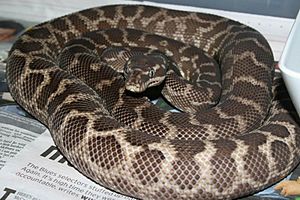Rough-scaled python facts for kids
The rough-scaled python (Morelia carinata) is a special type of large snake found only in Australia. It's known for its unique rough scales. This amazing python doesn't have any different types or subspecies that we know of right now.
Quick facts for kids Rough-scaled python |
|
|---|---|
 |
|
| Rough-scaled python pictured in captivity. | |
| Conservation status | |
| Scientific classification | |
| Genus: |
Morelia (snake)
|
| Species: |
carinata
|
| Synonyms | |
|
|
Contents
What Does It Look Like?
The rough-scaled python can grow to be about 2 meters (6.5 feet) long. That's taller than most grown-ups! It has a head shaped like a triangle. There's a clear narrow part right behind its head, like a neck.
This snake is special because of a large scale on top of its head. It also has bumpy, keeled scales on its back. These scales have a ridge down the middle. Its body is thin but very strong and muscular.
The python's colors can be light honey-tan with darker reddish-brown spots. Or it can be dark brown with pale brown blotches. The blotches get bigger towards its tail. This makes the pattern look like it's upside down. Its belly is white, sometimes with black spots. These markings help the snake hide in its surroundings. The rough scales also help it climb on rocks and in cracks.
A scientist named L.A. Smith first officially described this snake in 1981. He wrote about it in a science paper.
Rough-Scaled Pythons in Zoos
Rough-scaled pythons are now kept by private owners. They first came from a few snakes caught in the wild. Scientists found that these pythons breed easily when they are cared for by humans.
In 2000, five rough-scaled pythons were brought to the Australian Reptile Park. By 2012, these snakes had produced 71 baby pythons. Those babies then started having their own young too!
Where Do They Live?
You can find the rough-scaled python in northwestern Western Australia. They live near the Mitchell and Hunter Rivers. This area is just a bit inland from the coast.
The first place where this snake was officially found was near the Mitchell River Falls. This is in Western Australia.
They live in rocky valleys in the Kimberley region. This is in the far north of Western Australia. They like to climb on low trees and shrubs in monsoon rainforests. This snake has one of the smallest living areas of any snake species. They are also found in the Charnley River–Artesian Range Wildlife Sanctuary.
These snakes are often found near trees that have fruit. This might be because they like to wait there for plant-eating animals. They also like to be close to fresh water that is always there.
How Do They Behave?
So far, scientists have only seen these pythons active during twilight. This means they are most active around dawn and dusk. They are usually quite calm and gentle. They rarely try to bite people.
Life Cycle: Reproduction
The rough-scaled python lays eggs. This is how all pythons have their babies. The mating season for these snakes is usually in July and August.
A female python typically lays about ten eggs. She then coils around her eggs. She keeps them warm until they hatch. Once the baby snakes hatch, the mother does not stay to take care of them.


